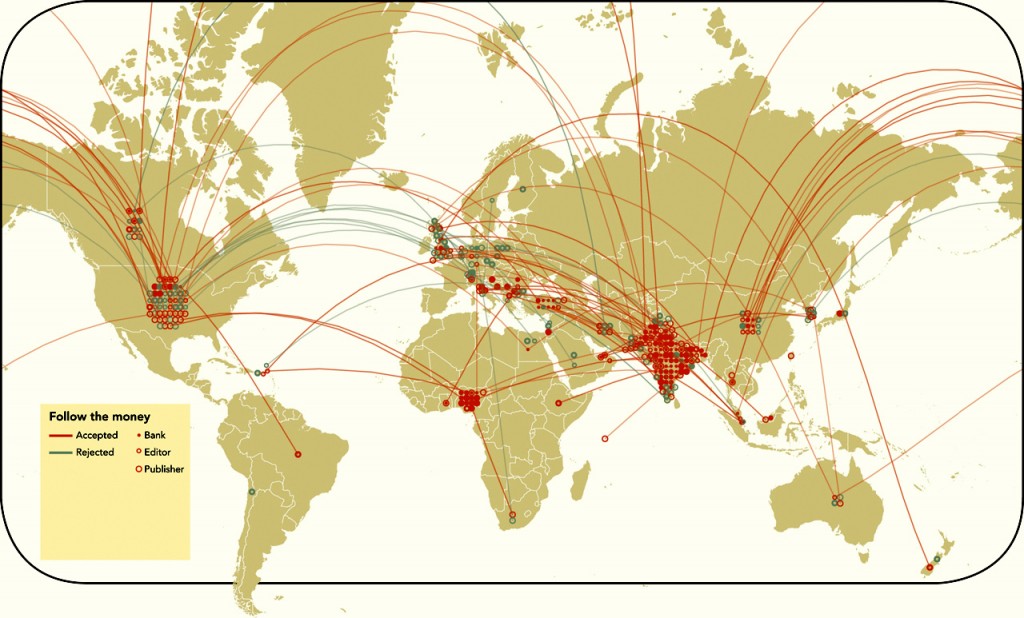As many of you might be aware, in a brilliant exposé titled “Who’s Afraid of Peer Review? ” Science mag’s John Bohannon unearthed the failings of the peer review process in the open-access publishing industry.
Background: The sting operation
John Bohannon’s ingenious plan involved creating a database of molecules, lichens, and cancer cell lines and using a computer program to generate hundreds of unique papers. A typical skeleton of the paper looked like this: Molecule “X” from lichen species “Y” inhibits the growth of cancer cell line “Z”. All the papers were submitted under fictitious names. He then sent several versions of this bogus article to various open-access journals and recorded the acceptance rate. The targets of his sting operation were open-access publishers: 167 publishers from the Directory of open access journals (DOAJ), 121 publishers from Beall’s list, and 16 that were listed by both (a total of 304 publishers).
The flawed paper:

Typically if a journal rejected the paper then Bohannon did not pursue it further. However if a journal notified acceptance then he sent an e-mail stating that in the process of revision, a serious flaw was noticed which invalidates the conclusions. Subsequently he withdrew the paper. However surprisingly despite the withdrawal some journals published the flawed article anyway.
Jeffrey Beall has tracked the flawed articles which were published and has made them available in this blog post here.
Notably the flawed paper “7-Chloronorlichexanthone Inhibits the Growth of Murine SV40 Transformed Lymphoid Sarcoma Cells in vitro” was accepted and published by OMICS publishing group (the article has been removed from OMICS website since). This flawed paper can be accessed here. Readers may remember that I had blogged about OMICS group questionable practices and defamation lawsuit over here.
Anyone with a basic knowledge of science can easily identify the flaws in the paper. The paper claims dose dependent effect of the 7-Chloronorlichexanthone (wonder drug: lichen active) on Lymphoid Sarcoma Cell growth in vitro. But the results and the data indicate an almost identical effect on the cancer cell growth, across a wide range of concentrations. The control group should contain all the ingredients except the one being tested; in this case control group should have been ethanol and phosphate buffered saline but instead the paper states that a growth medium was used as control. Thus the lichen active’s observed anti-tumour effect is just the cytotoxic effect of ethanol which was used to dissolve the lichen active!
The second experiment is even more absurd. The control cells weren’t irradiated at all! The so called “radio sensitization” effect of the lichen active is nothing more than well documented anti-tumour effect of radiation. Such an egregiously flawed paper should have been rejected outright, but a whopping 51% acceptance rate indicates the poor quality control standards of this journals.32% of the journals rejected this paper and PLOS one was one of the few journals to point out the scientific and ethical flaws in the paper.
India: emerging as the hub of dubious publishers

About a-third of the journals (around 100 journals out of 304) targeted in this sting exercise are based in India. Furthermore the flawed paper acceptance rate was 64% and the rejection rate mere 15% .Alarming indeed (see image alongside). These predatory publishers have journal names which closely resemble legitimate publishers; American journal of polymer science etc; only that there’s nothing remotely American about it.
Their modus operandi involves spamming scientists and researchers soliciting manuscripts and conveniently omitting to mention author fee. Later after the manuscript is published they demand a hefty fee from the surprised authors. Oftentimes since scientists have to assign copyright, they are unable to withdraw the paper and publish elsewhere.
Flawed research: Dire consequences?
Flawed research endangers people’s lives. When it’s too far away from the market to do so, it squanders public money and also the time and efforts of some of the best minds.
As the economist aptly states “A rule of thumb among biotechnology venture-capitalists is that half of published research cannot be replicated. Last year researchers at one biotech firm, Amgen, found they could reproduce just six of 53 “landmark” studies in cancer research. Earlier, a group at Bayer, a drug company, managed to repeat just a quarter of 67 similarly important papers. In 2000-10 roughly 80,000 patients took part in clinical trials based on research that was later retracted because of mistakes or improprieties.”
Open access vs. Subscription based: Is it fair to blame open access?
A significant limitation of John Bohannon’s sting operation was that it did not target subscription based journals (no negative control so to speak!). For all we know this flawed paper would have been accepted by a significant number of subscription based journals too. Maybe it’s not the author-pays to publish open access model which is flawed, the fault lies with peer review. As Michael Eisen UC Berkeley biologist, states in his blog “But the way to fix this is not to curtain open access publishing. It is to fix peer review.” Perhaps the solution lies in making the peer review process more open and transparent, including post publication appended comments. Readers please do chip in with your comments and thoughts on this.
Meanwhile, Scientists can keep their eyes open and avoid these dubious publishers by performing some basic internet searches and checking Beall’s list of predatory publishers.

Brilliant read. Thank you.
Thanks RG 🙂